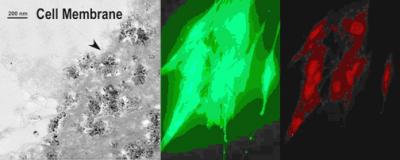Toxicity in two types of universal nanomaterials
Two groups of independent scientists in the US have published new research results showing that iron (Fe) nanoparticles and short nanotubes can pose risks to human and animal health.
The first team led by Sungho Jin (University of California, San Diego) discovered that iron-containing nanoparticles can be toxic to nerve cells. The second group led by Matthew Becker and colleagues at the National Institute of Standards and Technology (NIST, USA) discovered that single-walled nanotubes shorter than 200 nm can easily enter lung cells.
In recent times, nanoparticles contain iron (Fe, Fe 3 O 4 . particles) which have been strongly researched for application in biomedical technologies such as drug delivery, cell selection, treatment. cancer, magnetic resonance and many other applications . Iron oxide nanoparticles (Fe 3 O 4 ) are an important candidate for drug application and cell kill, malignant tumors. Because iron is a basic component in mammalian cells (eg Fe in red blood cells), it is thought that nanoparticles containing Fe are completely harmless to organisms.
However, recently, Jin's team and colleagues at the University of California, San Diego observed the toxic effect appearing in nerve cells covered by iron nanoparticles. When placed in nanoparticles, many cells have died and others have reduced ability to produce neurons - extremely necessary for the transmission of nerve signals (see picture). first). This toxicological discovery will be published in Biomaterials magazine, as a warning that this material is not as harmless as we think - according to Jin.

Figure 1. Photographs of PC12 neurons covered by iron oxide nanoparticles (Group results at University of California, San Diego will be published on Biomaterials)
Simultaneously with this study, Becker's team (NIST) discovered that lung cells easily absorb single-walled nanocarbon tubes that cover DNA when the size of the tube is shorter than 200 nm. Depending on the concentration of the nanomaterials, cells may die or cause different toxic effects. In contrast, nanotubes longer than 200 nm cannot enter the cell (Figure 2).

Figure 2. Results of the group at NIST published in Advanced Materials: Nanocarbon tubes through human lung cells.
We have long known that nanocarbon tubes have excellent mechanical properties and electrical conductivity. They can be used for many applications in technology and industry as their biocompatible properties so far we know very little."Our results have shown that penetrating lung cells depends on the length of the nanotubes," Becker explained. "This will be the first step in many of the next steps in research goals. limiting the health effects of nanotubes ". The results of the group at NIST have just been published in Advanced Materials.

Are these Fe 3 O 4 nanoparticles completely harmless to human health?
The Doctrine of Independence
- Detecting new carbon nanomaterials
- Successfully combining super new nanomaterials
- Google, Universal will sell DRM zero music
- For the first time, a nanomaterial has been created that is both liquid and solid
- Nanotechnology and applications
- The toxicity of the three-chamber ants is 15 times stronger than the snake's venom
- Create 'universal fingerprint', capable of unlocking the security of current smartphones
- By attaching to a dehumidifier, nanomaterials can create water from 'nothingness'.
- Thousands of chemicals need to be re-evaluated for toxicity
- Software helps people to speak 26 languages
- Growth stimulants are still controversial about toxicity
- Strong swine influenza virus toxicity when transmitted to humans
 'Barefoot engineer' invents a pipeless pump
'Barefoot engineer' invents a pipeless pump Process of handling dead pigs due to disease
Process of handling dead pigs due to disease Radiometer
Radiometer Warp Engine: Technology brings us closer to the speed of light
Warp Engine: Technology brings us closer to the speed of light Good news: New cancer drug discovered that causes cancer cells to 'starve'
Good news: New cancer drug discovered that causes cancer cells to 'starve'  Why do we get older when cells are always replicating?
Why do we get older when cells are always replicating?  Shocking Research: Human Memory Doesn't Exist Only in the Brain
Shocking Research: Human Memory Doesn't Exist Only in the Brain  Reasons for easy weight gain: Obesity has 'memory' and retains mechanisms in cells
Reasons for easy weight gain: Obesity has 'memory' and retains mechanisms in cells  What happens to cancer cells after they die?
What happens to cancer cells after they die?  New Breakthrough: 'Hack' Tumors, Turn Cancer Cells Into Pills
New Breakthrough: 'Hack' Tumors, Turn Cancer Cells Into Pills 